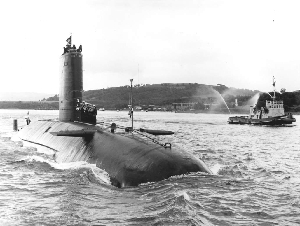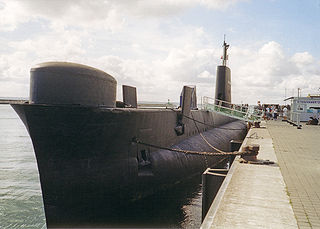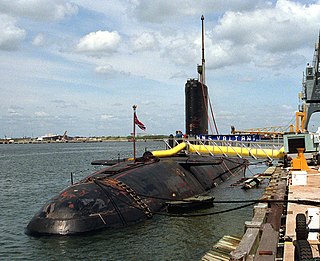
The Upholder/Victoria-class submarines, also known as the Type 2400, are the class of the diesel-electric submarines built in the United Kingdom in the 1980s to supplement the nuclear submarines in the Submarine Service of the British Royal Navy.

HMS Astute (P447) was an Amphion-class submarine. Her keel was laid down by Vickers at Barrow-in-Furness. She was launched in 1944 and commissioned in 1945.
The Mark 24 Tigerfish was a heavyweight acoustic homing torpedo used by the Royal Navy (RN) during the 1980s and 90s. Conceptual development dates to the mid-1950s, and formally started in 1959 with a target introduction date in 1969. A lengthy development process led to a greatly reduced performance requirement, including the removal of anti-surface capabilities. The first prototype "Tiger Fish" examples were delivered in 1967.

HMCS Victoria is a long-range hunter-killer (SSK) submarine of the Royal Canadian Navy, the lead ship of her class. She is named after the city of Victoria, British Columbia. She was purchased from the Royal Navy, and is the former HMS Unseen (S41). The class was also renamed from the Upholder class.

HMS Invincible was the Royal Navy's lead ship of her class of three light aircraft carriers. She was launched on 3 May 1977 as the seventh ship to carry the name. She was originally designated as an anti-submarine warfare carrier, but was used as an aircraft carrier during the Falklands War, when she was deployed with HMS Hermes. She took over as flagship of the British fleet when Hermes was sold to India. Invincible was also deployed in the Yugoslav Wars and the Iraq War. In 2005, she was decommissioned, and was eventually sold for scrap in February 2011.

HMS Conqueror was a British Churchill-class nuclear-powered fleet submarine which served in the Royal Navy from 1971 to 1990. She was the third submarine of her class, following the earlier Churchill and Courageous, that were all designed to face the Soviet threat at sea. She was built by Cammell Laird at Birkenhead.

The Type 21 frigate, or Amazon-class frigate, was a British Royal Navy general-purpose escort that was designed in the late 1960s, built in the 1970s and served throughout the 1980s into the 1990s.

The seventh HMS Dreadnought was the United Kingdom's first nuclear-powered submarine, built by Vickers Armstrongs at Barrow-in-Furness. Launched by Queen Elizabeth II on Trafalgar Day 1960 and commissioned into service with the Royal Navy in April 1963, she continued in service until 1980. The submarine was powered by a S5W reactor, a design made available as a direct result of the 1958 US–UK Mutual Defence Agreement.

The Oberon class was a ship class of 27 British-designed submarines operated by five nations. They were designed as a follow-on from the Porpoise class; physical dimensions were the same but stronger materials were used in hull construction and improved equipment was fitted.

ARA San Luis (S-32) was a Type 209 diesel-powered submarine of the Argentine Navy. Built in Germany, San Luis has a displacement of 1,285 tonnes and was commissioned in 1974. The submarine operated against the Royal Navy during the Falklands War without any noticeable success, but survived a number of anti-submarine sweeps carried out by British frigates. San Luis was struck in 1997 after an incomplete overhaul.

HMS Plymouth was a Royal Navy Rothesay-class frigate. In 1982, Plymouth was one of the first Royal Navy ships to arrive in the South Atlantic during the Falklands War.
HMS A5 was an early Royal Navy submarine. She was a member of Group Two of the first British A class of submarines. Like all members of her class, she was built at Vickers Barrow-in-Furness.

The sixth and most recent HMS Valiant was the second of Britain's nuclear-powered submarines, and the first of the two-unit Valiant class.

HMS Sealion (S07) was a Porpoise-class submarine.

The three Churchill class, sometimes known as the Repeat Valiant-class submarines were nuclear-powered fleet submarines which served with the Royal Navy from the 1970s until the early 1990s. The Churchill class was based on the older Valiant class, but featured many internal improvements.

HMS Revenge (S27) was the fourth of the Royal Navy's Resolution-class ballistic missile submarines.

HMS Olympus was an Oberon-class submarine that served in the Royal Navy, and later in the Canadian Forces as a submarine trainer.

HMS Osiris (S13) was an Oberon-class submarine that served in the Royal Navy.

The Bluff Cove air attacks occurred 8 June 1982, during the Falklands War. British troop transport ships were bombed by the Argentine Air Force (FAA) while unloading at Bluff Cove, with significant damage and casualties.
Several British 21-inch (533 mm) torpedoes have been used by the Royal Navy since their first development just before the First World War.
















